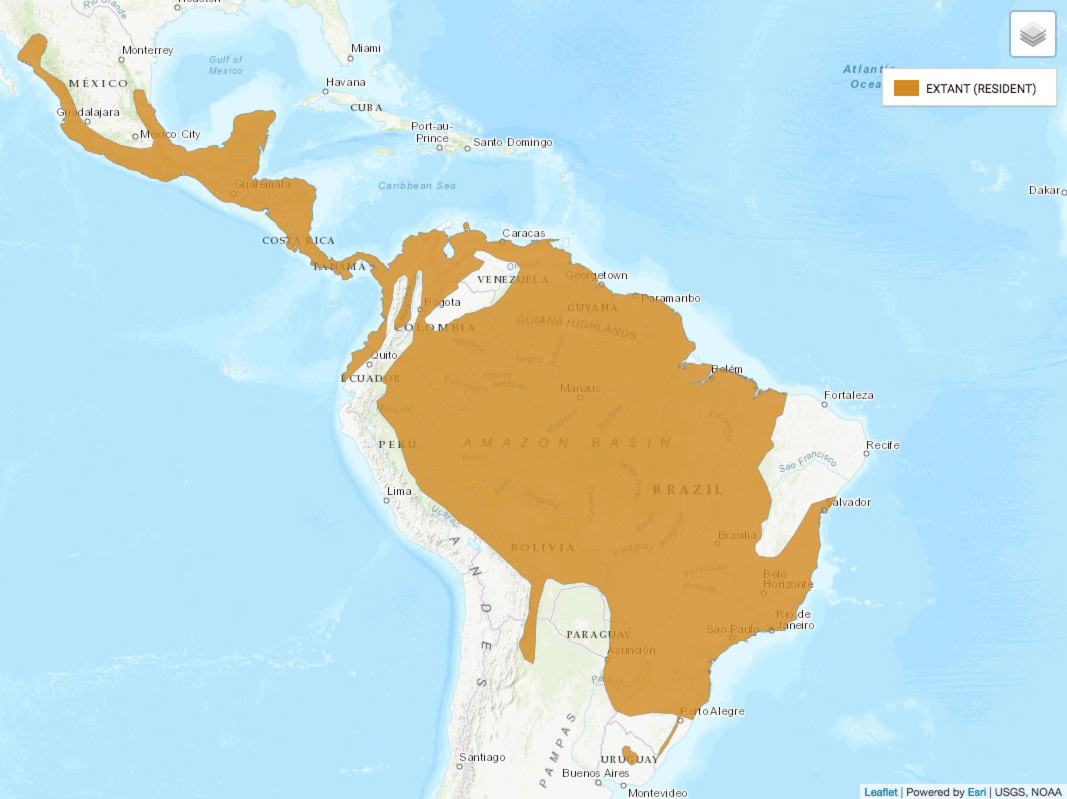Margay
Leopardus wiedii
©Adriano Gambarini
Taxonomy
Standard English Name
Margay
Scientific Name
Leopardus wiedii
Brazilian common name/s
Gato-maracajá, Gato-peludo
Conservation status - IUCN
Physical Description
Margays have a spotted coat that is very similar to that of the Ocelot and Ocilla, with dark rosettes on a yellow-gold background arranged mainly on the sides of the body. The rosettes on the back may merge into stripes that go from the top of the eyes to the base of the tail. It is a small animal, with a total length of 70 to 90 cm and weighs about 3.5 kg. The ankles of their hind legs can rotate 180 degrees, which gives them the rare ability to descend head first from trees, like squirrels. This adaptation combined with a long tail gives Margays an exceptional arboreal ability and they spend most of their time above the ground in forest trees.
Ecology and Habitat
They have a wide distribution that extends from northern Mexico to Uruguay and northern Argentina. Their presence is always associated with forests.
It is a little studied animal with limited information about their social characteristics. Studies have shown mainly nocturnal habits.
The main items in their diet are small arboreal rodents, followed by small birds, arthropods and fruits.
Gestation lasts 66 to 84 days, with litters of 1 to 2 cubs.
Threats and Conservation
Hunting for its fur and the destruction of forests are the main threats to this species. In addition, little is known about the biology of this species, which limits the ability to generate effective conservation strategies. It is classified by the IUCN (International Union for Conservation of Nature) as vulnerable and by IBAMA, as threatened with extinction.
Online links
IUCN redlist (https://dx.doi.org/10.2305/IUCN.UK.2015-4.RLTS.T11511A50654216.en) presents a synthesis of current knowledge about distribution and conservation status.
IUCN Cat Specialist Group species accounts: http://www.catsg.org/index.php?id=89
References
Espinosa, C. C., Trigo, T. C., Tirelli, F. P., da Silva, L. G., Eizirik, E., Queirolo, D., … & de Freitas, T. R. (2018). Geographic distribution modeling of the margay (Leopardus wiedii) and jaguarundi (Puma yagouaroundi): a comparative assessment. Journal of Mammalogy, 99(1), 252-262.
Horn, P. E., Pereira, M. J., Trigo, T. C., Eizirik, E., & Tirelli, F. P. (2020). Margay (Leopardus wiedii) in the southernmost Atlantic Forest: Density and activity patterns under different levels of anthropogenic disturbance. PloS one, 15(5), e0232013.
Nagy-Reis MB, Iwakami VHS, Estevo CA, Setz EZF. Temporal and dietary segregation in a neotropical small-felid assemblage and its relation to prey activity. Mamm Biol. 2019; 95:1–8.
Nascimento, F. O. D. (2010). Revisão taxonômica do gênero Leopardus Gray, 1842 (Carnivora, Felidae) (Doctoral dissertation, Universidade de São Paulo).
Pérez-Irineo G, Santos-Moreno A, Herna´ndez-Sa´nchez A. (2017). Density and activity pattern of Leopardus wiedii and Leopardus pardalis in Sierra Norte of Oaxaca, Mexico. Therya.; 8(3):223–32.
Peters, F. B., Mazim, F. D., Favarini, M. O., Soares, J. B., Oliveira, T. G., Castanõ-Uribe, C., … & Payán, E. (2016). Caça preventiva ou retaliativa de felinos por humanos no extremo sul do Brasil. II. Conflictos entre felinos y Humanos em América Latina. Castaño-Uribe, Serie Editorial Fauna Silvestre Neotropical. Instituto de Investigación de Recursos Biológicos Alexander von Humboldt (IAvH), Bogotá, DC, Colombia, 311-325.
Oliveira, T. G. (1998). Leopardus wiedii. Mammalian Species, 579, 1-6.
Oliveira, T. G., & Cassaro, K. (2005). Guia de campo dos felinos do Brasil. Instituto Pró-Carnívoros.
Oliveira, T., Paviolo, A., Schipper, J., Bianchi, R., Payan, E. & Carvajal, S.V. (2015). Leopardus wiedii. The IUCN Red List of Threatened Species 2015: e.T11511A50654216.
Rocha-Mendes, F., & Bianconi, G. V. (2009). Opportunistic predatory behavior of margay, Leopardus wiedii (Schinz, 1821), in Brazil. Mammalia, 73, 151-152.
Tortato, M. A., de Oliveira, T. G., de Almeida, L. B., & Beisiegel, B. de M. (2018). Leopardus wiedii. In: Instituto Chico Mendes de Conservação da Biodiversidade. (Org.). Livro Vermelho da Fauna Brasileira Ameaçada de Extinção: Volume II – Mamíferos. Brasília: ICMBio. p. 349-352.
Wang, E. (2002). Diets of ocelots (Leopardus pardalis), margays (L.wiedii), and oncillas (L.tigrinus) in the Atlantic rainforest in southeast Brazil. Studies on Neotropical Fauna and Environment, 37, 207-212.
